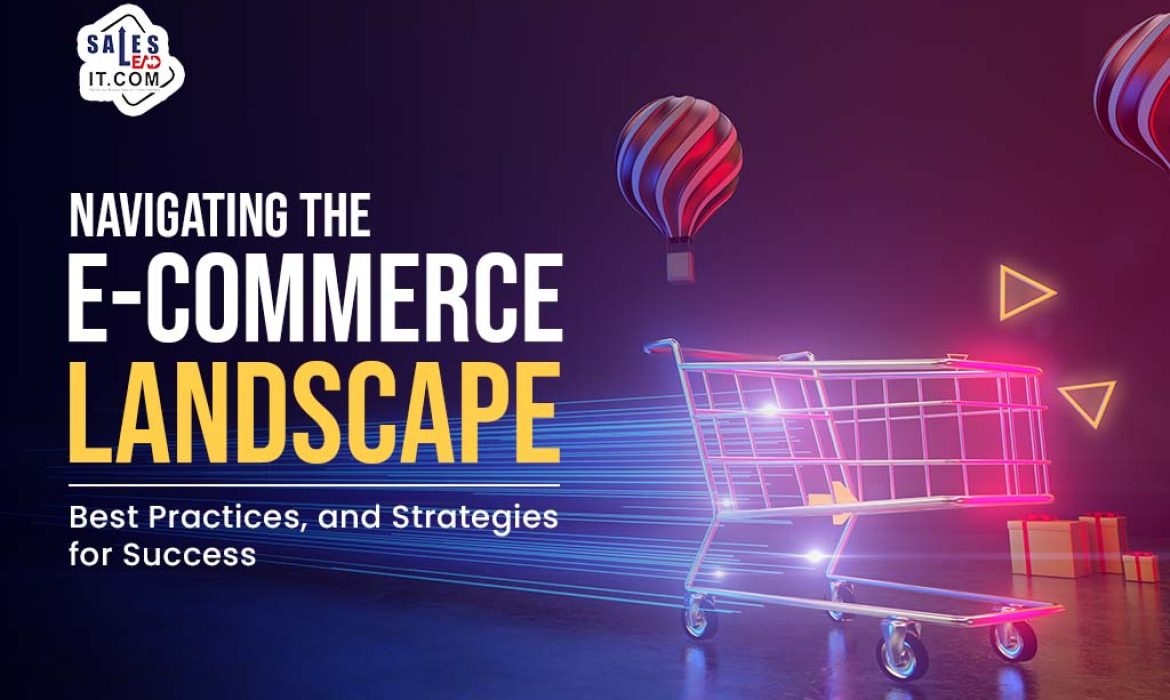Navigating The E-commerce Landscape: Trends, Best Practices, And Strategies For Success
Introduction:
In the ever-evolving realm of e-commerce, staying ahead of the curve is not just an advantage—it’s a necessity. As businesses increasingly shift their focus to the digital marketplace, understanding current trends, embracing best practices, and deploying effective strategies are key components for sustained success. In this blog, we delve into the dynamic world of e-commerce, exploring the latest trends, essential best practices for online selling, and strategies that businesses can leverage to thrive in the digital landscape.
E-commerce Trends: Adapting to the Future
- Personalized Shopping Experience: Customers now expect tailored experiences. Utilize data analytics to understand customer behavior, preferences, and purchase history, enabling personalized product recommendations and targeted marketing.
- Mobile Commerce (M-commerce): With the surge in smartphone usage, optimizing your e-commerce platform for mobile devices is non-negotiable. Responsive design, easy navigation, and mobile-friendly payment options are essential for capturing the growing M-commerce market.
- Augmented Reality (AR) and Virtual Reality (VR): Enhance the online shopping experience by integrating AR and VR technologies. Allow customers to virtually try products before purchasing, providing a more immersive and confident shopping experience.
- Sustainability and Ethical Practices: Conscious consumerism is on the rise. Showcase your commitment to sustainability and ethical practices, from sourcing to packaging. Transparent communication about your eco-friendly initiatives can build trust with environmentally conscious consumers.
- Voice Commerce: Voice-activated devices are becoming commonplace. Optimize your e-commerce platform for voice search to cater to the increasing number of consumers using virtual assistants like Siri and Alexa.
Best Practices for Online Selling: Elevating the Customer Experience
- User-Friendly Website Design: Your website is your digital storefront. Ensure it is visually appealing, easy to navigate, and offers a seamless, secure checkout process. A positive user experience is fundamental to retaining customers.
- Optimized Product Listings: Make your products stand out with clear, compelling product descriptions, high-quality images, and relevant keywords. Implement an effective search and filter system to simplify the browsing process for customers.
- Secure Payment Gateways: Security is paramount in e-commerce. Invest in robust payment gateways to ensure the safety of customer transactions. Clearly communicate your security measures to build trust.
- Customer Reviews and Testimonials: Encourage customers to leave reviews and testimonials. Positive feedback builds credibility and influences potential buyers. Responding promptly to customer inquiries and addressing concerns also contributes to a positive reputation.
- Seamless Multichannel Integration: Expand your reach by integrating your e-commerce platform with various channels—social media, marketplaces, and other online platforms. Consistent branding and messaging across channels enhance your brand’s visibility and coherence.
Strategies for Success in the Digital Marketplace:
- Data-Driven Decision-Making: Leverage data analytics to gain insights into customer behavior, sales trends, and marketing performance. Use this information to refine your strategies, optimize product offerings, and personalize marketing campaigns.
- Social Media Marketing: Harness the power of social media platforms for marketing and customer engagement. Utilize targeted ads, influencer collaborations, and engaging content to connect with your audience and drive traffic to your e-commerce site.
- Dynamic Pricing Strategies: Implement dynamic pricing based on market demand, competitor pricing, and customer behavior. Offering discounts, limited-time promotions, and personalized pricing can enhance competitiveness and attract more customers.
- Customer Loyalty Programs: Retaining existing customers is as important as acquiring new ones. Implement loyalty programs, exclusive discounts, and personalized offers to reward customer loyalty and encourage repeat business.
- Continuous Innovation: Stay agile and open to innovation. Regularly update your product offerings, embrace emerging technologies, and adapt to changing consumer preferences to remain competitive in the dynamic digital marketplace.
Conclusion:
As the e-commerce landscape continues to evolve, businesses that stay attuned to trends, embrace best practices, and implement effective strategies are poised for success. By combining innovation with a customer-centric approach, your e-commerce venture can thrive in the digital marketplace and build lasting success in the ever-expanding world of online retail.
Unleashing Growth: A Strategic Guide to Scaling Your Business
Introduction
Embarking on a journey of business expansion requires more than just ambition—it demands a thorough understanding of scaling strategies, risk management, and effective execution. In this article, we delve into the essentials of scaling, from its core concepts to tangible steps for preparing, strategizing, and measuring success.
Understanding the Concept of Scaling for Growth
Scaling isn’t just about revenue. It’s a holistic approach to expanding operations, reaching more customers, and ensuring sustained profitability. This article explores how scaling empowers businesses to handle increased demand, deliver more products or services, and generate higher revenues.
The Importance of Scaling in Business
Scaling is the linchpin for long-term success. It attracts new customers, retains existing ones, explores new markets, and fosters innovation. Discover why scaling is imperative for businesses looking to thrive in a competitive landscape.
Key Elements of Scaling for Growth
Scaling involves a multi-faceted approach:
- Scalable Infrastructure: Invest in technology and upgrade systems to accommodate increased demand.
- Talent Acquisition and Retention: Hire and retain skilled employees to support business expansion.
- Streamlined Processes: Optimize workflows to handle increased volume efficiently.
- Financial Planning: Assess financial health and secure funding for scaling efforts.
- Market Research and Analysis: Understand market trends, customer preferences, and the competitive landscape.
- Customer Relationship Management: Build strong relationships with customers through excellent service and ongoing support.
- Marketing and Branding: Create awareness and attract new customers through effective marketing strategies.
Preparing Your Business for Scaling
Before scaling, evaluate your business’s readiness:
- Conduct Market Research: Identify untapped opportunities and validate demand for your products or services.
- Analyze Competitors: Understand their market share and identify gaps to exploit.
- Assess Operational Capacities: Evaluate production capabilities, supply chain logistics, and organizational structure.
Effective Strategies for Scaling Your Business
- Adopting Technology: Leverage digital transformation with CRM systems, cloud computing, data analytics, and tools for remote work.
- Building Strategic Partnerships: Collaborate with partners who complement your business, share values, and offer expertise.
- Managing Risks: Mitigate cash flow challenges, maintain quality standards, handle increased customer demands, and address operational complexities.
Measuring the Success of Your Scaling Strategy
Use key performance indicators (KPIs) to evaluate:
- Revenue Growth Rate
- Customer Acquisition Cost
- Customer Lifetime Value
- Customer Retention Rate
- Operational Metrics
Adjusting Your Strategy Based on Performance
Stay agile, be willing to make strategic changes, and align your scaling strategy with long-term business goals. Continuously evaluate customer feedback, market trends, and competitor actions to optimize growth.
Embark on your scaling journey armed with knowledge, and watch your business reach new heights of success.
Boost Your Business Presence: Unleashing Winning Marketing and Branding Tactics!
INTRODUCTION:
Every new business needs to establish popularity first by either delivering an astonishingly unique product or by using a memorable marketing strategy. Most businesses take up the habit of properly studying and analyzing their target audience before finalizing a marketing strategy. This analysis should be done periodically, as occasionally the target audience’s taste may change and if the business fails to adapt to the changes, they’ll end up missing their customers.
Most businesses take up either traditional marketing methods or digital marketing methods, but currently businesses are building a base with traditional marketing and are expanding digitally. Let us look at some of the methods a business can boost their visibility on a digital platform.
BRANDING STRATEGIES:
- Creation of Engaging Content
An engaging content simply means a content that draws maximum attention just at a single glance. These posts mostly contain images (elements) or wordings (copy) that are eye-catching and interesting. These are a proven technique used by many brands to convey their advertisement concepts.
- Collab with Reputed Influencers
Influencers are individuals who have a numerous number of followers. These influencers can be content creators, vloggers, reviewers, or even business owners. When engaging in a collaboration both the parties will find it beneficial as the followers of both the accounts will start following the other account.
- Increase Your Online Presence
Make your audience know that you are available on all social media platforms and establish credibility by being responsive to all and every interaction your audiences have with you. Don’t wait for interactions, make interactions too. Explore new platforms and test its usability and master its hacks.
- Employee Advocacy
A company’s employees are the first and primary advocates for their products or services. Take the testimonials of your employees after you’ve made them sample your product or record their reviews about the company. This will create a sense of trust among the audience and will trigger them to at least test the product themselves.
- Contribute to Your Community
Show your audience that you are a socially driven group that will not stand aside during the public’s hardships and will do their utmost in contributing to the community whenever possible. A socially responsible company will score goodwill along with credibility, this will ensure an unshakable trust upon the company.
- Make Connections with Your Target Audience
Don’t wait to be approached, it is always a great idea to make the first move. Primarily know who your target audiences are, build a strong persona this template will help filter your audiences. Once you’ve finalized your audience, study them and know where they are highly active and what makes them take action.
- Proper SEO Strategy
SEO (Search Engine Optimization) is the best organic method to rank higher in the Search Engine Results Page (SERP). Analyze which keywords are highly functional and use those keywords in on-page and off-page sections to boost its strength even further. Ensure these keywords are not stuffed and are used in the right moderations.
- Run Contest & Giveaways
Giveaways and contests are now a trending strategy that several small brands have taken up to boost sales and their visibility in social media platforms. You can also try this strategy with the right products, in the right medium, in the right time, and with the most attractive advertising posters.
- Run Paid Ads
Organic approaches will help you build a strong base, but paid strategies will help you gain visibility and will pull new clients. Paid ads should be taken into consideration once your products and social media account is in its optimal stage, as the social media platform will do an analysis on your account to figure out how, when and who to target.
- Build A Functional Website
Along with a strong social media account a business also needs a highly functional and optimized website. A brand’s website should hold all its details and ways to contact the respective person to learn further details or to make orders. A website can be static, dynamic or e-commerce based, the type of website can be chosen based on the nature of your business.
CONCLUSION:
One business’s failure can be another business’s success, hence copying or duplicating a business’s strategy will be no use. Every business should have its own strategy after proper study of the market’s climate and the target audience’s taste as well as preference. Businesses should leverage both traditional marketing strategies as well as digital marketing strategies to reap high conversions and pull more clients as well as audience.



